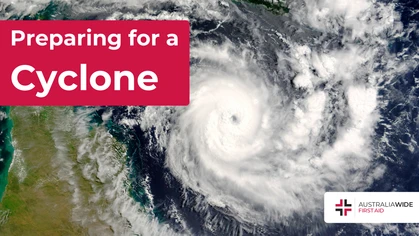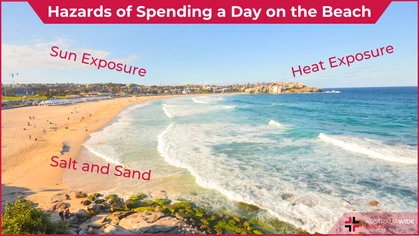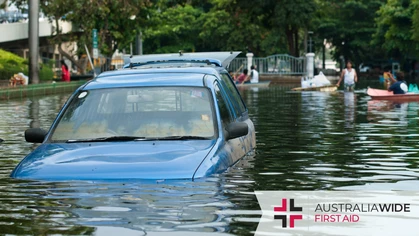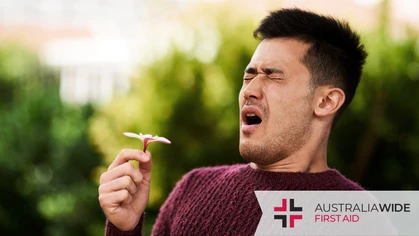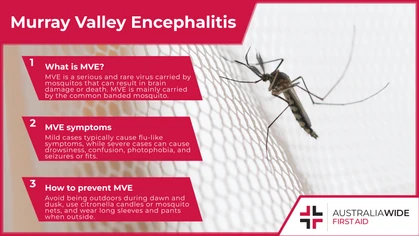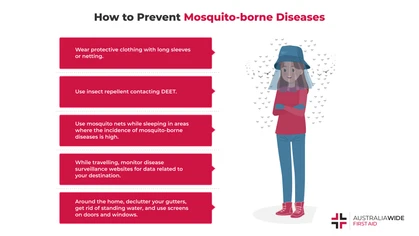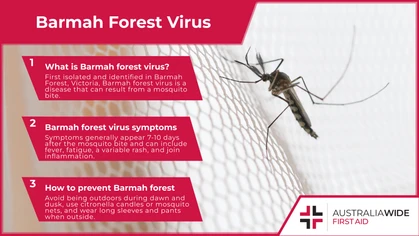Bluebottle Jellyfish Treatment and Prevention

Seasonal Concerns
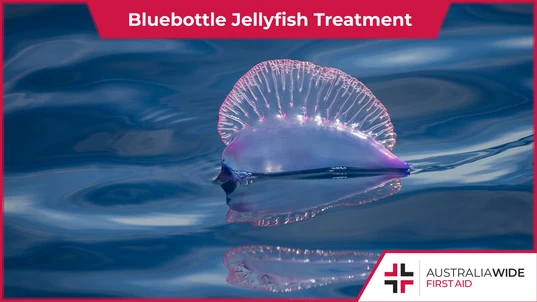
Popular along the Australian east coast during summer, the Bluebottle jellyfish has stinging cells that contain toxic proteins and can cause intense pain, swelling, and even allergic reactions.
Going to the beach is a favourite pastime among Australians. But like most Australian pastimes, the beach is littered with native fauna that can inflict bites and stings ranging from the painful to the fatal. One such creature is the Bluebottle jellyfish, or Indo-Pacific Man o'War, an unsurprisingly blue-coloured siphonophore that is commonly encountered during summer on the eastern coast of Australia. Continue reading for more information about the Bluebottle jellyfish and how to treat and prevent their stings, which can cause intense, long-lasting pain and even allergic reactions. We also cover jellyfish and other marine stings in our first aid courses: Head to our website to find a training location near you today.Appearance
As we mentioned earlier, the Bluebottle jellyfish is a siphonophore. As such, it is not a single animal, but a colony of four highly modified polyps that depend on one another for survival:- The pneumatophore forms the most recognisable feature of the Bluebottle - the float, a blue, gas-filled, pear-shaped sac that can exceed 15cm
- The dactylozooids form part of the long, blue tentacles (which can reach lengths of 10 m) and are responsible for the detection and capture of prey
- The Gastrozzoids also form part of the tentacles and are responsible for digesting prey
- The tentacles also comprise the Gonozooids, which are responsible for reproduction
Distribution
The Bluebottle float has aerodynamic properties and is often carried by warm currents to more temperate waters. As such, they are commonly encountered during summer on the Australian east coast. They are also regularly spotted on exposed ocean beaches after being washed ashore by strong onshore north easterly winds. It is important to remember, as Bluebottles are common in non-tropical areas, jellyfish stings in tropical waters should be treated as a suspected Box jellyfish or Irukandji sting.Symptoms
Humans can sustain a sting if they come into contact with the stinging cells on the Bluebottle's predatory tentacles, which contain a toxic mix of phenols and proteins. Symptoms of a Bluebottle jellyfish sting include:- Trails of blue tentacles adhering to the body or limbs
- Stinging sensation associated with the contact
- Reddening of the skin
- Pain for some hours
- Severe allergic reaction (very rare)
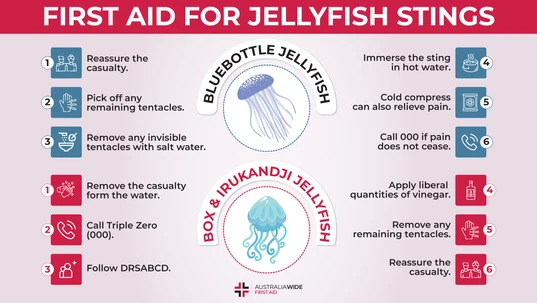
Bluebottles predominantly occur in non-tropical waters. In tropical waters, meanwhile, there are two jellyfish types that can cause potentially fatal envenomation: Box jellyfish and Irukandji jellyfish. As such, all suspected jellyfish stings in tropical waters should be treated with vinegar.
Treatment for Bluebottle stings
In the event of a Bluebottle jellyfish sting:- Monitor the casualty while offering them comfort and reassurance
- Pick off any remaining tentacles
- Remove any 'invisible tentacles' with a copious amount of sea water
- Immerse the affected area in hot water or cover it with hot running water (as in a hot shower) for at least 20 minutes to kill the proteins in the venom*
- Alternatively, you can cover the affected area with a dry cold pack for pain relief
- Call Triple Zero (000) for an ambulance if you begin experiencing an allergic reaction, if the pain is generalised or persistent, or if the sting site is larger than half a limb or involves a sensitive area, such as the eyes
- Seek assistance from a lifeguard if they are nearby and available
Looking to get you First Aid knowledge up to date?
We run certified First Aid courses throughout all major Acustralian citys. Find a location near you.
Prevention
To prevent a Bluebottle jellyfish sting:- Avoid swimming in the ocean when warning signs about jellyfish are on display
- Don't touch any jellyfish in the water or on the beach
- Wear a Lycra wetsuit or other protective clothing when swimming and waterproof footwear when wading through shallow water
Final thoughts
Bluebottle jellyfish have stinging cells that contain a potent mix of phenols and proteins and can cause intense pain and redness upon contact with human skin. If you are stung by a Bluebottle, you can usually treat the symptoms by immersing or covering the affected area in hot water. Wrapped ice packs can also provide relief. You should seek medical attention if the affected area is significant, the pain does not cease, or you begin experiencing an allergic reaction. For more information on treating Bluebottle and other marine stings, enrol in one of our first aid courses: Head to our website to find a training location near you today.
Originally published at
https://www.australiawidefirstaid.com.au/resources/bluebottle-jellyfish-treatment
as part of the Australia Wide First Aid Articles Library

